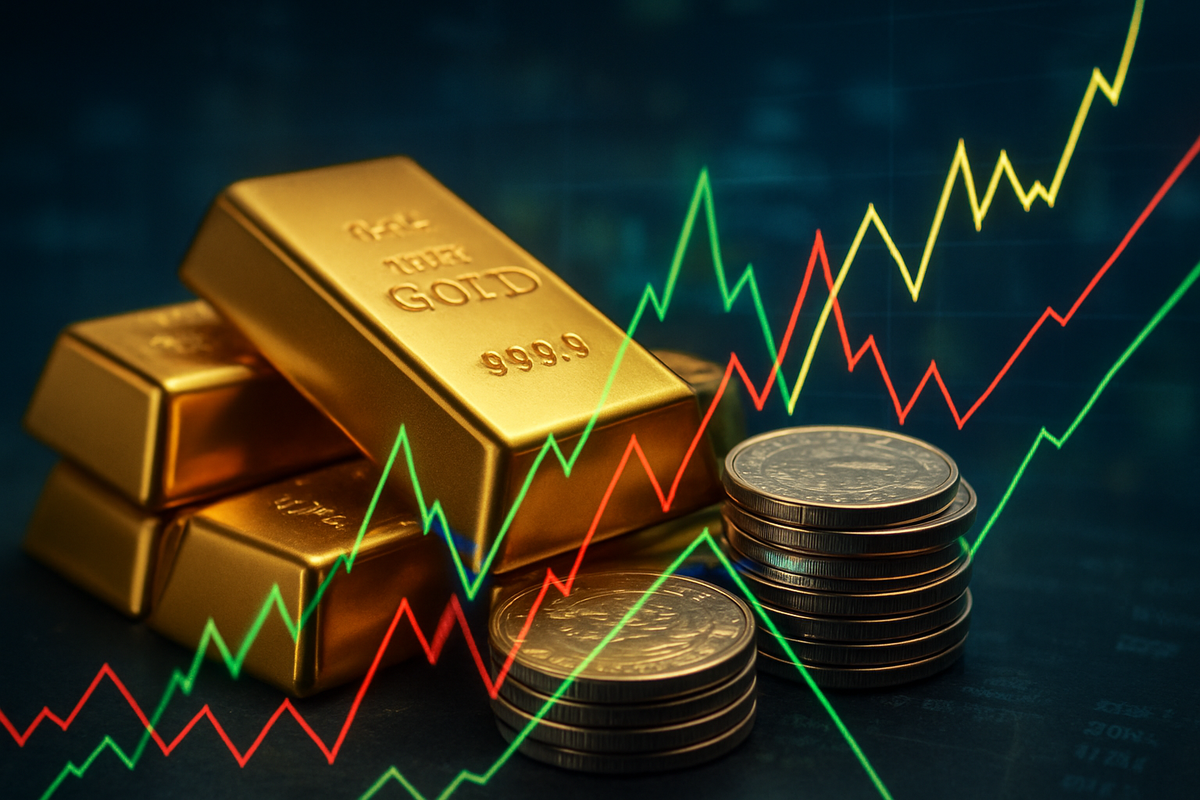
November 2025 has ushered in a period of intense intraday volatility for both gold and silver, transforming the precious metals market into a high-stakes arena for day traders and short-term investors. These rapid price fluctuations, driven by a complex interplay of macroeconomic shifts, geopolitical tensions, and technical market dynamics, have created both unprecedented profit opportunities and magnified risks. As the market navigates these turbulent waters, understanding the underlying currents is paramount for those looking to capitalize on, or simply survive, the daily swings.
Unpacking the Turbulent Swings: A Detailed Look at November's Precious Metals Market
The month of November 2025 has been a testament to the unpredictable nature of precious metals. Silver, in particular, grabbed headlines with an astonishing surge, reaching an all-time high of $54.42 per troy ounce on November 14, following a remarkable 12.8% rally over just four trading days. Intraday swings for silver frequently exceeded 4%, with weekly movements often topping 10%. Gold, while more tempered, also saw significant action, hitting an intraday peak of $4,250 around the same period, albeit with a more modest 1.9% weekly gain.
However, these ascents were often met with sharp reversals. Just a day later, on November 15, spot gold prices plummeted by over 3%, or more than $130, nearing $4030 per ounce, while spot silver prices declined by 4%, approaching $50 per ounce. These declines were largely triggered by hawkish comments from U.S. Federal Reserve officials, which dampened expectations for a December interest rate cut. Domestically in India, the impact was even more pronounced, with gold prices plunging nearly ₹5,000 per 10 gram on November 14, and silver rates seeing a steeper decline of ₹8,700 per kilogram. This period also saw an initial phase of profit-taking in late October and early November, followed by a robust rally, indicating a resilient underlying bullish sentiment despite the sharp corrections.
Several factors have converged to fuel this rapid intraday volatility. The U.S. Federal Reserve's policy stance and interest rate sentiments remain a primary driver; any hawkish rhetoric or signals against rate cuts diminish the appeal of non-yielding assets, leading to sharp sell-offs. Conversely, hints of potential rate cuts can send prices soaring. The strength of the U.S. dollar also plays a crucial role, as a stronger dollar makes dollar-denominated precious metals more expensive for international buyers, thereby suppressing demand.
Geopolitical developments and broader economic uncertainties continue to act as catalysts for safe-haven demand, bolstering gold and silver prices. However, any easing of tensions or resolution of uncertainties, such as the end of a U.S. government shutdown, can reduce this safe-haven appeal, contributing to price corrections. Profit-taking by both institutional and retail investors after substantial gains also leads to temporary but sharp price corrections. For silver, its dual role as an industrial commodity and a monetary asset, coupled with strong industrial demand (especially from renewable energy technologies) and structural supply deficits, contributes to its higher volatility. The recent addition of silver to the U.S. critical minerals list further amplified its rally. Lastly, reduced market liquidity, over-the-counter trading volumes, and technical phenomena like 'gamma squeezes' in thin markets have amplified price movements. The recent U.S. government shutdown, creating a "data blackout" by delaying crucial economic indicators, has significantly amplified market uncertainty and volatility, with the eventual release of this data expected to keep prices choppy.
Corporate Fortunes in Flux: Winners and Losers in a Volatile Market
The intense intraday volatility observed in gold and silver prices around November 2025 has created a bifurcated landscape for public companies across the precious metals ecosystem, impacting miners, refiners, traders, and related industries. The rapid swings present both amplified opportunities for some and significant headwinds for others, depending on their operational efficiency, hedging strategies, and exposure to the metals.
Mining companies, by their very nature, are highly susceptible to price fluctuations due to their significant operational leverage. When gold and silver prices soar, their revenues increase dramatically, while relatively fixed costs lead to exponential profit margin expansion and amplified stock performance. Conversely, sharp intraday declines can quickly erode profitability, particularly for those with higher operating costs or insufficient hedging. Around November 2025, many gold miners have opted against extensive hedging, aiming to maximize revenue from current high prices, a strategy that amplifies both potential gains and losses during periods of extreme volatility.
Potential winners in this environment include mining giants with robust balance sheets and efficient, low-cost operations such as Agnico Eagle Mines (NYSE: AEM), lauded for its strong management and profit growth, and Newmont Corporation (NYSE: NEM) and Barrick Gold Corporation (NYSE: GOLD), which, as major producers, are poised to capitalize on high realized prices despite potential production volume declines. SSR Mining Inc. (NASDAQ: SSRM) has also been highlighted as a top performer. These companies, with their operational leverage, can translate even modest price appreciation into significant profit margin expansion. Conversely, miners with less efficient operations, higher production costs, or substantial debt are vulnerable to rapid price drops, which can swiftly squeeze margins and revenues.
Beyond mining, the impact extends to other sectors. Gold streaming and royalty companies, like Franco-Nevada (NYSE: FNV), often emerge as significant winners. Their business model, involving upfront financing to miners in exchange for a percentage of future production or royalties, allows them to benefit from rising spot prices without direct exposure to mining's operational risks and variable costs. Their margins widen with higher metal prices, often leading to smoother returns during price swings compared to direct miners. Precious metals trading companies and investment firms, including those managing ETFs like SPDR Gold Shares (NYSEARCA: GLD) and iShares Silver Trust (NYSEARCA: SLV), can see increased trading volumes and assets under management during periods of high interest and rising prices, boosting fees and commissions. Agile traders and quantitative firms are also well-positioned to exploit intraday movements through sophisticated algorithms.
However, the volatility also creates losers. Industrial users of silver, spanning the solar, electronics, and electric vehicle sectors, face increased input costs due to silver's strong rally. Companies heavily reliant on silver as a critical component could see their profitability impacted, potentially leading to higher consumer prices or an accelerated search for substitute materials. Jewelry manufacturers also contend with higher and more volatile raw material costs, complicating inventory and pricing management. Furthermore, brokerage firms face increased risks of margin calls and potential client defaults if volatile positions turn sour quickly, while investment firms with unhedged long positions can suffer substantial losses during sharp, unexpected price corrections. In essence, while the long-term bullish sentiment for precious metals persists, the current intraday turbulence demands exceptional agility, robust risk management, and a keen understanding of market dynamics for all players.
Beyond the Daily Swings: Broader Implications of Precious Metals Volatility
The intraday volatility in gold and silver prices around November 2025 is not merely a trading phenomenon; it is a significant indicator of broader economic and geopolitical currents, carrying ripple effects across various industries and demanding attention from regulators. This market behavior aligns with several overarching trends that underscore the enduring importance of precious metals in the global financial landscape.
At its core, the heightened volatility reinforces the safe-haven status of gold and silver in an era marked by persistent economic uncertainty and geopolitical instability. As central banks worldwide continue to diversify their reserves away from the U.S. dollar and as concerns over monetary debasement and inflation grow, investors are increasingly drawn to tangible assets. This trend, often termed the "debasement trade," reflects a global effort to safeguard purchasing power against systemic and geopolitical risks. Central banks, in particular, have been aggressive accumulators of gold, a strategic move that provides a "central bank gold put," helping to cushion downward price movements and signaling a long-term bullish outlook for the metal.
The ripple effects of this volatility extend widely. For mining companies and refiners, while rising prices can lead to exceptional financial performance, significant intraday swings compress profit margins and revenue forecasts, potentially leading to revised production guidance and adjustments in capital expenditure. Industrial consumers, especially those heavily reliant on silver for critical technologies like solar panels, electronics, and electric vehicles, face fluctuating input costs. This can compel them to implement sophisticated hedging strategies, optimize inventory management, or even explore alternative materials to mitigate risk. The jewelry industry also grapples with higher and more volatile raw material costs, influencing pricing and consumer demand, potentially shifting preferences towards more affordable precious metals.
From a regulatory standpoint, sustained intraday volatility can trigger calls for enhanced market oversight, particularly in futures markets, to ensure stability and protect investors. Existing frameworks, such as the London Bullion Market Association's (LBMA) Global Precious Metals Code, provide guidelines for ethical conduct and risk management, but periods of extreme turbulence often test these boundaries. Central bank monetary policies, including interest rate adjustments and quantitative easing, remain pivotal, as they directly influence the attractiveness of non-yielding assets. Furthermore, governmental actions, such as shutdowns or tariff decisions, can introduce substantial volatility by disrupting economic data flows and creating political uncertainty premiums. International regulatory cooperation is also increasing, with bodies in the EU and UK implementing recommendations for margin transparency in commodity markets in response to recent crises.
Historically, the current dynamics bear striking resemblances to past periods of market turmoil. Silver, with its dual industrial and investment demand, has consistently exhibited higher volatility than gold, often experiencing price swings 2 to 2.5 times larger in percentage terms. Episodes like the high inflation and geopolitical instability of the 1970s and 1980s, the 2008 financial crisis, and the 2011 market highs all saw significant surges and subsequent corrections in precious metals prices. These historical precedents confirm that sharp corrections are often linked to shifts in central bank monetary policy or robust economic growth that diminishes safe-haven demand, reinforcing the notion that the "excess volatility" observed today is a recurring feature of commodity markets driven by short-term investor sentiments and overreactions.
The Road Ahead: Navigating the Future of Precious Metals
The intense intraday volatility observed in gold and silver prices around November 2025 sets the stage for a dynamic period ahead, characterized by both near-term uncertainty and a generally bullish long-term outlook. Investors and market participants must prepare for continued fluctuations while positioning themselves to capitalize on underlying fundamental strengths.
In the short term, the precious metals market is likely to remain choppy, marked by periods of consolidation and potential price corrections. Analysts suggest a near-term bearish bias for gold, with possible pullbacks towards support levels of $4,000-$3,920 per ounce, while silver may stabilize around the $48-$49 mark after its recent highs. These corrections are largely viewed as healthy consolidations following extended rallies. The immediate trajectory will be heavily influenced by upcoming U.S. economic data, particularly nonfarm payrolls, and the subsequent impact on the Federal Reserve's interest rate decisions. Shifting expectations for a December rate cut will continue to be a primary driver of uncertainty, while ongoing geopolitical tensions are expected to provide a floor for prices, supporting potential upside breakouts as precious metals maintain their safe-haven appeal.
Looking further out, the long-term outlook for both gold and silver remains largely bullish, with many experts predicting continued appreciation and new record highs. The World Gold Council (WGC) anticipates an upside for gold prices over the next 18 months, with leading forecasters projecting levels between $4,400 and $5,300 per ounce by 2026, and some even expecting it to approach $5,000 within the next 12 months. Silver is widely expected to maintain its strength, potentially outperforming gold in 2026, with forecasts ranging from an average of $33.96 to aggressive scenarios suggesting $65 to $100 per ounce. Key long-term drivers include persistent inflation concerns, a potentially weaker U.S. dollar, range-bound interest rates, highly uncertain geo-economic environments, robust investment demand, and continued central bank purchases, particularly from emerging markets diversifying their reserves.
For investors, strategic adaptations are paramount. A multi-asset diversification strategy, allocating 5-15% of a portfolio to precious metals, can enhance Sharpe ratios and reduce drawdowns during equity market stress. Dollar-cost averaging—buying at regular intervals regardless of short-term price swings—is a reliable method to build positions, smooth volatility, and capture long-term upside. Holding physical gold and silver (coins, bars) is recommended for wealth preservation, offering stability and eliminating counterparty risk. Experienced investors may also leverage the gold-silver ratio (currently around 75:1, historically averaging 50:1 to 60:1) to time accumulation, with extreme readings often signaling opportunities. Risk management is crucial, and investors should be prepared for potential corrections of 15-25% during normal bull market conditions, viewing these as accumulation opportunities rather than fundamental deterioration.
Market opportunities abound, particularly in "buying the dips" during current corrections for long-term investors. Silver, in particular, may be undervalued relative to gold given the historically high gold-silver ratio, presenting significant upside potential if the ratio normalizes. Its strong and growing industrial demand in green energy technologies (solar panels, electric vehicles) positions it for dynamic growth, potentially outperforming gold during economic expansions. However, challenges persist, including continued short-to-medium-term volatility, interest rate uncertainty from the Federal Reserve, potential U.S. dollar strength, and the unlikely but possible de-escalation of geopolitical tensions. Regulatory changes, such as shifts in tax exemptions in major consuming countries, could also impact demand. Ultimately, while significant pullbacks remain a short-term risk, the most likely long-term scenario is a continued bullish trajectory driven by global economic uncertainties, inflation, central bank buying, and robust industrial demand for silver, potentially pushing gold towards $5,000 and silver towards $65-$100 by 2026.
The Enduring Allure: A Comprehensive Wrap-up of Precious Metals Volatility
The closing weeks of November 2025 have etched a memorable chapter in the annals of precious metals, characterized by significant intraday volatility that followed earlier record-breaking rallies. While both gold and silver demonstrated robust gains for much of the year, recent hawkish signals from the U.S. Federal Reserve, temporary easing of safe-haven demand, and strategic profit-taking have introduced sharp, albeit potentially temporary, corrections. This period underscores the enduring significance of precious metals in a diversified portfolio and offers critical insights for navigating future market dynamics.
The key takeaway from this turbulent period is the resilience of precious metals amidst a complex global landscape. Gold, surpassing $4,300 per ounce in October and reaching an intraday peak near $4,393, and silver, achieving an all-time high of $54.42 per troy ounce on November 14, showcased their strength. These gains were fueled by persistent global inflationary pressures, a growing trend of de-dollarization driven by aggressive central bank gold accumulation, and robust industrial demand for silver from the burgeoning renewable energy and electronics sectors. The subsequent corrections, triggered by Fed commentary, the resolution of the U.S. government shutdown, and profit-taking, were met by dip-buyers, indicating strong underlying support and a belief in their long-term value.
Moving forward, the market assessment remains broadly bullish for both gold and silver in the near to medium term. Projections from institutions like J.P. Morgan Research anticipate gold prices averaging $3,675 per ounce by Q4 2025 and climbing towards $4,000 by mid-2026, with some forecasts even eyeing $4,250 per ounce. Silver is expected to consolidate between $40-$60, with bullish scenarios potentially pushing prices beyond $70 per ounce by 2026-2027. The fundamental drivers underpinning this optimism—including ongoing geopolitical uncertainty, persistent inflationary pressures, continued central bank demand, expectations of future monetary policy easing, robust industrial demand for silver, and concerns over the U.S. fiscal outlook—are expected to persist. However, risks such as overheated prices leading to further profit-taking, a stronger U.S. dollar, or unexpectedly strong economic data that delays rate cuts could introduce renewed downward pressure.
The lasting impact of this period of volatility solidifies gold's role as the quintessential safe-haven asset and a hedge against inflation and geopolitical instability. The unprecedented demand from central banks, projecting 750-900 tons for the full year 2025, represents a fundamental realignment in global financial power dynamics. Silver's exceptional performance highlights its growing importance beyond just being "poor man's gold," with its dual nature as both a monetary and industrial metal, particularly its increasing utility in green technologies, positioning it as a compelling long-term growth story. The observed sharp price swings reinforce the inherent volatility in the silver market, making it an attractive yet riskier proposition for investors seeking higher upside potential.
For investors navigating the coming months, a strategic and informed approach is paramount. Closely monitor central bank policy, especially the U.S. Federal Reserve's stance on interest rates and future monetary easing, as this will heavily influence price trajectories. Track geopolitical developments, as new risks can quickly reignite safe-haven demand. Keep a keen eye on the U.S. Dollar Index (DXY), as a stronger dollar typically exerts downward pressure on dollar-denominated precious metals. Observe key technical levels for both gold (e.g., $4,000 psychological support, resistance at $4,045, $4,075, $4,140-$4,100, and $4,240-$4,265) and silver (e.g., $47.30, $49.30, $50, $52, and $52.50-$52.10) to identify potential entry and exit points. Finally, assess industrial demand for silver, particularly in renewable energy and electronics, and be prepared for potential profit-taking events after significant rallies. In essence, while short-term volatility is likely to persist, the current correction appears to be a healthy consolidation, and precious metals continue to offer essential portfolio diversification and a hedge against ongoing global uncertainties.
This content is intended for informational purposes only and is not financial advice






